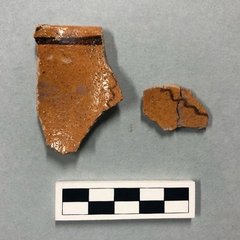These ceramic sherds were recovered during excavations within the Alamo Church in Excavation Unit 6, from level 31–35 inches below datum. These sherds are a variety of the Galera Ware.
Galera Ware is a type of thin ceramic that is believed to originate out of Jalisco, Mexico, more specifically, the town of Tlaquepaque. The ware was first identified in Texas during archeological excavations in 1968. It can be found at most Spanish Colonial Sites in Texas.
These ceramics were made using a mold, rather than throwing on a wheel. They are typically orange to brick red in color, and exhibit black, white, yellow, and green decorations. The most common forms of intact vessels were bean pots, serving dishes and platters, cups (tazas), and chocolate pots. Decorations typically consist of dots, black/brown vine-like and feather-like lines, and rim bands.
These sherds exhibit the lighter orange body color, thin brown-black decoration, and thin, clear lead glaze. The sherds themselves are very thin, indicating that this was a delicate vessel. Two of the sherds recovered from the unit fit together. All three appear to be from the same vessel because they share the same decoration motif of a thin, wavy line.
Similar looking ceramics continued to be manufactured today.



